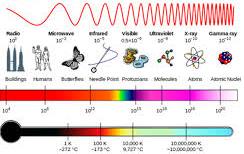The energy of radiations is the energy carried by electromagnetic waves or particle radiation. It is directly proportional to the radiation’s frequency and inversely proportional to its wavelength. For electromagnetic radiation, this energy can be calculated using Planck’s equation, E = hf, where E is energy, h is Planck’s constant, and f is frequency.
The energy carried by a radiation determines the maximum kinetic energy gained by a photoelectron after it’s extracted to the metal surface.
A circuit shown can be used to investigate the relationship between the frequency of the radiation and the kinetic energy of the photoelectrons.

Frequency is varied using different color filters. for each color filter, the potential difference is varied by moving the jockey between X and Y until no current is registered. The battery is connected in such that it opposes the ejection of electrons by attracting the ejected photoelectrons back to the cathode. The voltmeter reading gives the stopping potential for a given frequency.
Different color filters will allow different frequencies to fall on cathode. This determines the energy of the photoelectrons and so the energy needed to stop them. Table below shows typical results obtained for stopping potential for radiations of varying frequencies.
| Color | Frequency f(x 1014 Hz) | Stopping potential Vs |
| Violet | 7.5 | 1.2 |
| Blue | 6.7 | 0.88 |
| Green | 6.0 | 0.60 |
| Yellow | 5.2 | 0.28 |
| Orange | 4.8 | 0.12 |
When a graph of stopping potential Vs against frequency f is obtained, it looks like the one shown below.

As can be observed, the graph is a straight line that cuts the horizontal axis at 4.5.
The equation of the graph can be fitted into the Einstein’s equation.
The work done by the stopping potential is given by eVs
The work-energy theorem states that the net work done on an object is equal to the change in its kinetic energy. This means that when work is performed on an object, energy is transferred, causing its kinetic energy to increase or decrease.
From the work energy theorem;
substituting the above in the Einstein’s equation, we obtain:
making the energy expression to be the subject we get;
hence
however, hfo is the work function Wo of the metal.
From the graph, we can see that when Vs = 0;
and so f=fo
The graph of Vs against f therefore cuts the frequency axis at fo .
The slope of the graph is h/e and Vs intercept is -wo/e.
when we obtain the gradient of the graph, we can calculate the plank’s constant from the equation:
Values from energy of radiations graph
From our graphs above; we can obtain the threshold frequency of the metal using the equation:
when Vs = 0;
and so f=fo
from the graph, the value of f at Vs=0 is 4.5 x 1014Hz which is the threshold frequency.
Energy of radiations from the graph
let us take two arbitrary points from the graph:(3,-0.51) and (8.4, 1.5)
h = gradient x e
h = 3.907 x 1015 x 1.6 x 10-19 = 6.2512 x 10-34Js

